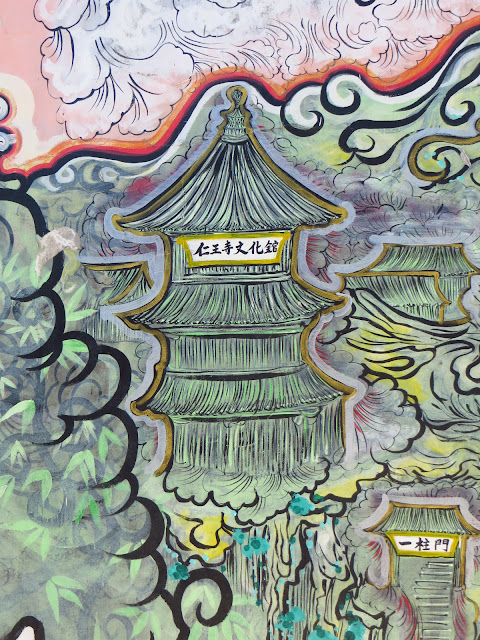With the new construction came a new "face" to the mountain. Whenever an apartment complex is built, the building-financing company(-ies) are responsible for preparing a communal area adjacent for children's play and adults to walk or rest. And it might be that since the mountain was already a spiritual place and development on it would spoil the traditional atmosphere, I'm guessing that some of the development money was spent on making the mountain more accessible to the new apartment dwellers by replacing the wandering, narrow, broken-cement steps leading to the spiritual heights with a wide staircase and beautifying that staircase with painted themes of mountain spirits, raging tigers, celestial clouds and other symbols of longevity and paradise. Truly beautiful! The artwork does cloak the touches of modernity with a sense of esoteric spiritual appeal.
Another change. On the mountain-side now are clear "walking trails" labeled for the visitor. Obviously tourism has taken hold here and the privacy preferred in shamanic gut (exorcisms) and deep undisturbed meditations are drifting into the past.
One of the biggest "attractions" on the mountain is the "Gijaam", the strangely shaped, dark-pitted rocks erupting skyward in an otherwise rounded-stone mountain. The odd rock formation is believed to be inbued with spiritual powers and to be highly propitious, and as such, is the rock for petitioning one's child-bearing prayers. Another name for the rock is "Seonbawi"--"Seon" (Zen) is for meditation and "bawi" means rock, thus, meditation rock. It was called this as it resembles a monk wearing a long-sleeved Buddhist robe. Two different legends are told about this rock: Some say that it looks like King Taejo, the founding king of Joseon, and his close friend, Master Monk Muhak. Others say that it looks like King Taejo and his queen.
 |
| With Buddha's birthday approaching, lanterns are strung in all Buddhist temples, and because Buddhism and shamanism have shared so much through the centuries, why not decorate the shamanic sites too? |
 |
| Meditating in a field of dappled color. |
 |
| The propitious "Gijaam" or "Seonbawi". |
 |
| Pigeons also find the rock propitious, and have a home where, as luck would have it, from which no one is likely to chase them away. |
For those interested, the rock is listed as Seoul Folklore Material No. 4. I am unable at present to find a list of folklore material in its entirety, so unfortunately have no idea just how many there are.





No comments:
Post a Comment